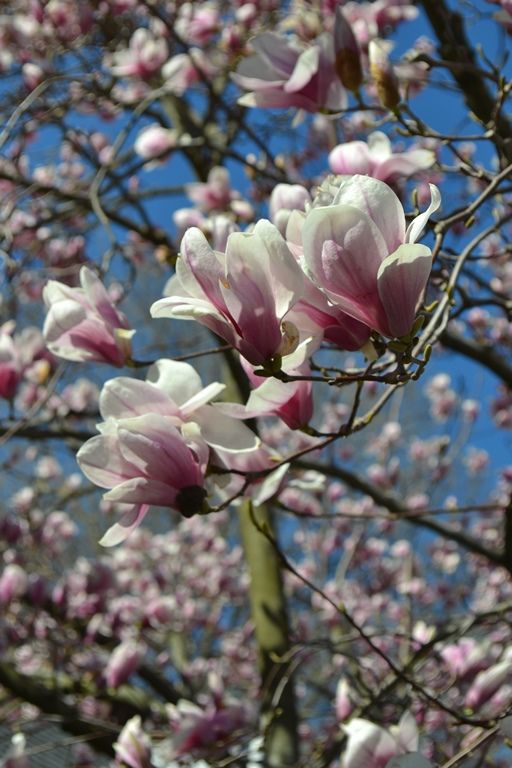
The Magnolia – the symbol of elegance
By: shortfinals
Tags: Bodnant Gardens, Botanic Gardens Conservation International, Cretaceous Period, Derbyshire, England, extinction, Flora & Fauna International, garden, gardener, magnolia, Magnolia wolfii, Magnolia x soulangeana, Magnoliaceae, National Collection of Magnolias, National Trust, plant, Plant Life, Victorians, Wales
Category: British Isles, England, Plants, Prehistory
It all started with my Great Aunt Eliza. When I was growing up, in a tiny village in Derbyshire, I knew that she was a relative of my father, and lived in a Victorian brick house just down the road. She was a widow, and had a huge back garden which was somewhat neglected. However, in the middle of the overgrown garden stood a magnificent tree, fully 40 feet high. I did not know what it was, except that Great Aunt called it a ‘tulip tree’, and sure enough, each Spring, it bloomed, and was covered with thousands of beautiful pink and white flowers that looked something like tulips! It was, of course, a magnolia. My father later grew a magnolia in his front yard, more than anything, I think, in remembrance of his Aunt Eliza. I would just like to mention that the actual ‘Tulip Tree’ is nothing like the variety found in English country gardens!
The family which contains more than 245 species of Magnolia plants – the Magnoliaceae – is extremely old. It is estimated that they date from the late Cretaceous Period, around 95 million years ago, a time of shallow and warm seas, and temperate conditions even close to the Poles. Indeed, they predate the butterflies, which would explain why they evolved to use beetles as their pollinators. The charity Plant Life estimates that there were around 100,000 now extinct species in the geological past! The primitive nature of their blossoms is also reflected in the fact the buds are covered by bracts rather than sepals (although both of these are types of leaf). The diverse species of magnolia successfully occupy ecological niches on several continents, and this could well be a reflection of the effects of continental drift.
The Magnolias are named after the famed French botanist, Professor Pierre Magnol (1638 – 1715), and because they are an old and fragmented family, there are STILL arguments about how they should be arranged and named. Suffice it to say that, currently, the Magnoliaceae consist of seven genera of 245 species, some of which are evergreen, some deciduous, and they are scattered across China and South East Asia, North, Central and South America. The Victorians, who were plant collectors almost to excess, brought dozens of magnolias back to Europe from Asia and South America, and the process of selective breeding and hybridization began almost at once in private collections and the gardens of large aristocratic houses.
The two major international organizations involved with monitoring the health of the Magnoliaceae worldwide are Flora & Fauna International and Botanic Gardens Conservation International and together they produce an annual ‘Red List’ of species under threat. The really bad news is that no less than 131 wild species of the family are listed as being under threat or in danger of extinction.
For example, Magnolia coriacea from south east Yunnan in China has a scattered population of an estimated 300 – 500 individuals. Magnolia dealbata discovered in a Mexican cloud forest at between 1,800 and 5,000 feet, by a Spanish expedition in 1570, has been reduced to four or five groups, for a total of between 80/100 trees. This has been caused by habitat destruction and the trees themselves being felled for timber! However, the worst case is Magnolia wolfii which is native to Risaralda Department, in Colombia. This is found in a tiny remnant of forest, and the TOTAL population consists of just three or four mature trees and two saplings. This patch of land is surrounded by coffee plantations, and despite desperate efforts to raise saplings, this species will almost certainly go extinct.
Much work on hybridization and propagation of various cultivars is still being done. In the U.K., the National Collection of Magnolias is located at Bodnant Gardens in Wales, a National Trust property, and is well worth a visit. Commercial growers have produced hardy hybrids which can be found across gardens all over Europe and North America. For example, the lovely mature tree you can see in the photograph above, in full bloom, is in the next street to mine in a suburb of Boston. This appears to be a Saucer Magnolia (Magnolia x soulangeana), possibly var. ‘Alexandrina’. This grows to between 15 and 18 feet tall at maturity, and has deciduous leaves. It produces masses of white and deep pink blossoms, usually in April. The blooms are around 4 inches across, are white inside and have a subtly sweet fragrance (they DID smell nice!) The leaves are a mid to dark green, and are obovate (‘egg-shaped’, and with the narrower end held on a stalk) and have a pronounced point. Since this variety is hardy to USDA Zone 4a (-25F to -20F) and Boston falls in Zone 6b to 7a (-5F to 0F), you can see that the tree is perfectly happy where it is.
I like magnolias, despite their short flowering season. They are beautiful, elegant and carry a subtle fragrance – rather like Great Aunt Eliza! I just wish there was some way to prevent the wholesale extinction of wild species, but I fear that this is something they share with amphibians, bees and many other forms of life in today’s precarious environment.

Growing up the “The South” of the United States I cannot imagine it without the Southern Magnolia tree 🙂 It would not be the same!
LikeLike